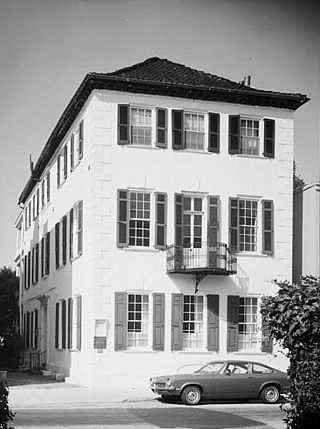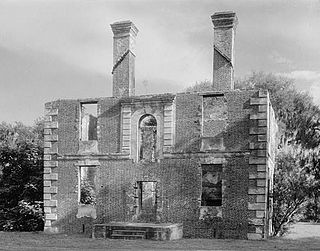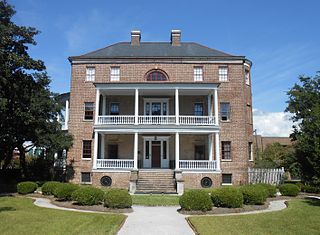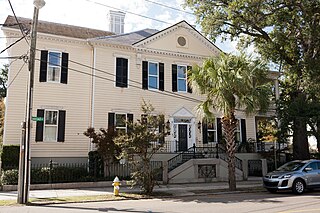
Denmark Vesey was a free Black and community leader in Charleston, South Carolina, who was accused and convicted of planning a major slave revolt in 1822. Although the alleged plot was discovered before it could be realized, its potential scale stoked the fears of the antebellum planter class that led to increased restrictions on both enslaved and free African Americans.

The Charles Pinckney National Historic Site is a unit of the United States National Park Service, preserving a portion of Charles Pinckney's Snee Farm plantation and country retreat. The site is located at 1254 Long Point Road, Mount Pleasant, South Carolina. Pinckney (1757-1824) was a member of a prominent political family in South Carolina. He fought in the American Revolutionary War, was held for a period as prisoner in the North, and returned to the state in 1783. Pinckney, a Founding Father of the United States, served as a delegate to the constitutional convention where he contributed to drafting the United States Constitution.

This is a list of the properties and historic districts in each of the 46 counties of South Carolina that are designated National Register of Historic Places.

The Old Slave Mart is a building located at 6 Chalmers Street in Charleston, South Carolina that once housed an antebellum-period slave-auction gallery. Constructed in 1859, the building is believed to be the last extant slave auction facility in South Carolina. In 1975, the Old Slave Mart was added to the National Register of Historic Places for its role in Charleston's African American history. Today, the building houses the Old Slave Mart Museum.

The Miles Brewton House is a National Historic Landmark residential complex located in Charleston, South Carolina. It is one of the finest examples of a double house in Charleston, designed on principles articulated by Andrea Palladio. Located on two acres, its extensive collection of dependencies makes it one of the most complete Georgian townhouse complexes in America. The house was built ca. 1765-1769 for Miles Brewton, a wealthy slave trader and planter.

The William Blacklock House is a historic house at 18 Bull Street in Charleston, South Carolina. A National Historic Landmark, this brick house, built in 1800 for a wealthy merchant, is one of the nation's finest examples of Adamesque architecture. It is now owned by the College of Charleston, housing its Office of the foundation.

The William Gibbes House is a historic house at 64 South Battery in Charleston, South Carolina. Built about 1772, it is one of the nation's finest examples of classical Georgian architecture. It was declared a National Historic Landmark in 1970.

The William Aiken House and Associated Railroad Structures make up a National Historic Landmark District in Charleston, South Carolina, that contains structures of South Carolina Canal and Railroad Company and the home of the company's founder, William Aiken. These structures make up one of the largest collection of surviving pre-Civil War railroad depot facilities in the United States. The district was declared a National Historic Landmark in 1963.

The Robert Brewton House is a historic house at 71 Church Street in Charleston, South Carolina. With a construction date at or before 1730, it is the oldest dated example of a "single" house. A single house is one room wide, with the narrow end towards the street, the better to catch cool breezes. It was declared a National Historic Landmark in 1960.

The Paul Hamilton House, commonly referred to as the Brick House Ruins, is the ruin of a 1725 plantation house on Edisto Island, South Carolina, that burned in 1929. It was designated a National Historic Landmark in 1970 for the unusual architecture of the surviving walls, which is partly based on French Huguenot architecture of the period.

The Charleston Historic District, alternatively known as Charleston Old and Historic District, is a National Historic Landmark District in Charleston, South Carolina. The district, which covers most of the historic peninsular heart of the city, contains an unparalleled collection of 18th and 19th-century architecture, including many distinctive Charleston "single houses". It was declared a National Historic Landmark in 1960.

The Charleston, South Carolina, studio of sculptor Clark Mills, was his first—he worked there from 1837 to 1848, when he moved to Washington, DC. The Charleston studio was designated as a National Historic Landmark in 1965. Before it became Mills' studio, the building, located at 51 Broad Street, Charleston originally served as a tenement house, and now houses professional offices.

The Joseph Manigault House is a historic house museum in Charleston, South Carolina that is owned and operated by the Charleston Museum. Built in 1803, it was designed by Gabriel Manigault to be the home of his brother, and is nationally significant as a well-executed and preserved example of Adam style architecture. It was declared a National Historic Landmark in 1973.

The Old Marine Hospital is a historic medical building at 20 Franklin Street in Charleston, South Carolina. Built 1831–33 to a design by Robert Mills, it was designated a National Historic Landmark in 1973 for its association with Mills, and as a high-quality example of Gothic Revival architecture. The hospital was built as a public facility for the treatment of sick sailors and other transient persons.

The Edward Rutledge House, also known as the Carter-May House and now The Governor's House Inn, is a historic house at 117 Broad Street in Charleston, South Carolina. This 18th-century house was the home of Founding Father Edward Rutledge (1749–1800), a signer of the United States Declaration of Independence and later Governor of South Carolina. Despite many changes to the house, it retains its 18th-century core dating to about 1760, and was declared a National Historic Landmark in 1971.

This is a list of the National Register of Historic Places listings in Charleston County, South Carolina.

Old Bethel United Methodist Church is located at 222 Calhoun Street, Charleston, South Carolina. It is the oldest Methodist church still standing in the city.

This is a list of the National Register of Historic Places listings in Charleston, South Carolina.

Emanuel African Methodist Episcopal Church, colloquially Mother Emanuel, is a church in Charleston, South Carolina, founded in 1817. It is the oldest AME church in the Southern United States; founded the previous year in Philadelphia, Pennsylvania, AME was the first independent black denomination in the nation. Mother Emanuel has one of the oldest black congregations south of Baltimore.
A House Divided: Denmark Vesey's Rebellion is a 1982 television film about Denmark Vesey, a literate skilled carpenter and former slave who planned a slave rebellion in 1822 in Charleston, South Carolina. Denmark Vesey's Rebellion was produced by WPBT and PBS, and Yaphet Kotto played Vesey.





















